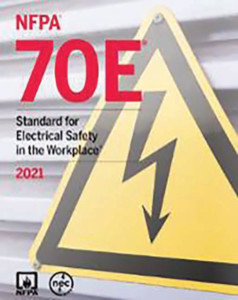
In September 2020, the newest (2021) edition of NFPA 70E, Standard for Electrical Safety in the Workplace® will be available to the industry. So how is it that such an important safety standard, put forth as a national consensus document, is reviewed, revised, and improved every three years? We’ll look at the process a little later in this article.
But first, let’s talk about this very important safety document, which on issuance becomes immediately active and enforceable…including any changes that have taken place. Unlike a code, this is a work practices document; therefore, any new requirements are now in effect, and there are no grandfathered rules and regulations.
For background on 70E, the NFPA website (www.nfpa.org) states the following:
While the number of workplace electrical injuries has declined in recent years, the risks of shock, electrocution, arc flash, and arc blast remain a significant health and safety concern. Each week nearly three workers die, and annually thousands are injured by electrical hazards. Many of these incidents could have been prevented through compliance with the latest safety codes and standards.
NFPA 70E, Standard for Electrical Safety in the Workplace is the quintessential resource for helping companies and employees reduce exposure to risks and reduce occupational injuries and fatalities. It was created to provide a document that meets the need of the Occupational Safety and Health Administration (OSHA) and is entirely consistent with the NEC and other applicable publications.
NFPA 70E provides provisions that help comply with OSHA 1910 Subpart S and OSHA 1926 Subpart K. This essential standard for anyone with interest in ending electrical-related accidents, liability, and loss offers expert information on subjects ranging from safety-related work practices to special equipment and maintenance requirements. Informative Annexes provide in-depth coverage of personal protective equipment (PPE), developments in electrical design, risk assessment and control, human performance and electrical safety, and many other critical topics.
After months of work by the NFPA 70E Technical Committee, the new 2021 edition features extensive changes, including:
- Revisions to Article 110 to incorporate the general requirements for electrical safety-related work programs, practices, and procedures from other articles
- References to arc-resistant switchgear in Tables 130.5(C) and 130.7(C)(15)(a) changed to arc-resistant equipment to address the use of other types of arc-resistant equipment
- Addition of Article 360, Safety-Related Requirements for Capacitors, and Annex R, Working with Capacitors, to address specific electrical safety requirements unique to capacitors
- Edits to Annex D, Incident Energy and Arc Flash Boundary Calculation Methods, to reference IEEE-1584-2018 as a method of calculation
What’s the Process to Get Here?
For the 70E and other consensus-based standards to go from a current edition to “new and improved” is quite an involved process, involving many people and many hours of focused and passionate contribution to the change. (Shout-out to all those who contribute!)
In the current cycle, 344 Public Inputs resulted in 85 First Revisions, and 155 Public Comments resulted in 46 Second Revisions. Compared to previous cycles, the workload was quite a bit less, so NFPA 70E may be approaching a “tweaking-the-words” maintenance cycle where major changes are increasingly rare, and it is principally revised to improve its clarity and usability.
In 2015, NFPA introduced a new process that was used for the 2021 edition. Under the old process, proposals for change were referred to as Proposals. Under the new process, Proposals are referred to as Public Inputs (PIs); Comments are now Public Comments (PCs); and the Report on Proposals (ROP) is now the First Draft (FD).
First Revision
Revisions made during the First Draft Meeting are balloted for acceptance in a First Revision (FR). The First Draft is circulated to committee members and posted on the NFPA website for public comments. It only takes a majority vote (51%) for an FR to be accepted by the committee during the meeting. However, a 66% majority vote is required to approve an FR when it is formally balloted by the committee. The First Draft is published on the NFPA website and is available at no charge to anyone who wants to submit a comment on a committee action. It is available for several months to ensure everyone has an opportunity to submit comments.
Second Draft
The Second Draft Meeting is different in that the committee is bound by any First Revisions and Public Comments (PCs) received. Any changes made at this meeting are Second Revisions (SRs). The Second Draft (SD), previously known as the Report on Comments, consists of committee actions that are balloted on and accepted from the Second Draft Meeting. These actions, known as Second Revisions (SRs), are used to create the Second Draft. Any First Revisions accepted by the committee at the First Draft Meeting that did not receive Public Comments are considered First Revisions, and no further action can be taken on them. People who wish to discuss PIs during the First Draft Meeting or PCs at the Second Draft Meeting can do so if they schedule a meeting in advance with the committee chairperson. Once the Second Draft Meeting has been completed, the standard is balloted. It takes a 66% majority vote to approve the Second Draft.
The Home Stretch
The NFPA consensus process is very thorough, allowing full public input and comment on committee actions. Many people consider it to be the best methodology for standards publication currently used by any organization. Public input is critical to the consensus process, and public input is solicited by NFPA using open announcements in news releases and in publications such as print and online magazines and trade journals. Any person can submit a PI online at the NFPA website (www.nfpa.org).
NFPA’s electrical oversight committee, the Correlating Committee, reviews the actions of the NFPA 70E Committee to ensure there are no major issues or inadvertent conflicts with earlier actions or other NFPA standards. When a Second Draft has been published and committee members or proposers still have differences of opinion, a Notice of Intent to Make a Motion (NITMAM) can be submitted to NFPA. NITMAMs are published on the NFPA website for public review and are discussed at the annual NFPA World Safety Conference and Exhibition.
Even after the revision cycle closes, another avenue to change the stardard is a Tentative Interim Amendment (TIA). A TIA can be submitted any time an error is found in the committee’s actions. For a TIA to be accepted, two conditions must be met: The change must correct an error, and the change must be an emergency in nature. For the 2021 cycle, no NITMAMs or TIAs have been submitted.
One final action that can be taken by the public is a Notice to Appeal. This does not occur often, as there is very-low probability that a Notice to Appeal will be considered once a NITMAM on the same committee action has already been considered. No Notice to Appeal actions were taken for the 2021 cycle.
Summary
The new edition of the 70E is out — so purchase a copy, familiarize yourself with the changes, understand the content and the very important work practice rules, and go through the day in a safe and planful way while working on or near electrical energy…whether at work or at home.
Be safe out there — and test before touch!
Ron Widup and Jim White are NETA’s representatives to NFPA Technical Committee 70E, Electrical Safety Requirements for Employee Workplaces. Both gentlemen are employed by Shermco Industries in Dallas, Texas, a NETA Accredited Company.
 Ron Widup, Senior Advisor, Technical Services and Vice Chairman of the Board of Directors, has been with Shermco Industries since 1983. He is a member of Technical Committee on NFPA 70E, Electrical Safety in the Workplace; a Principal Member of National Electrical Code (NFPA 70) Code Panel 11; a Principal Member of the Technical Committee on NFPA 790, Standard for Competency of Third-Party Evaluation Bodies; a Principal Member of the Technical Committee on NFPA 791, Recommended Practice and Procedures for Unlabeled Electrical Equipment Evaluation; a member of the Technical Committee on NFPA 70B, Recommended Practice for Electrical Equipment Maintenance, and Vice Chair for IEEE Std. 3007.3, Recommended Practice for Electrical Safety in Industrial and Commercial Power Systems. Ron also serves on NETA’s board of directors and Standards Review Council. He is a NETA Certified Level 4 Senior Test Technician, a State of Texas Journeyman Electrician, an IEEE Standards Association member, an Inspector Member of the International Association of Electrical Inspectors, and an NFPA Certified Electrical Safety Compliance Professional (CESCP).
Ron Widup, Senior Advisor, Technical Services and Vice Chairman of the Board of Directors, has been with Shermco Industries since 1983. He is a member of Technical Committee on NFPA 70E, Electrical Safety in the Workplace; a Principal Member of National Electrical Code (NFPA 70) Code Panel 11; a Principal Member of the Technical Committee on NFPA 790, Standard for Competency of Third-Party Evaluation Bodies; a Principal Member of the Technical Committee on NFPA 791, Recommended Practice and Procedures for Unlabeled Electrical Equipment Evaluation; a member of the Technical Committee on NFPA 70B, Recommended Practice for Electrical Equipment Maintenance, and Vice Chair for IEEE Std. 3007.3, Recommended Practice for Electrical Safety in Industrial and Commercial Power Systems. Ron also serves on NETA’s board of directors and Standards Review Council. He is a NETA Certified Level 4 Senior Test Technician, a State of Texas Journeyman Electrician, an IEEE Standards Association member, an Inspector Member of the International Association of Electrical Inspectors, and an NFPA Certified Electrical Safety Compliance Professional (CESCP).
 James (Jim) R. White, Vice President of Training Services, has worked for Shermco Industries since 2001. He is a NFPA Certified Electrical Safety Compliance Professional and a NETA Level 4 Senior Technician. Jim is NETA’s principal member on NFPA Technical Committee NFPA 70E®, Electrical Safety in the Workplace; NETA’s principal representative on National Electrical Code® Code-Making Panel (CMP) 13; and represents NETA on ASTM International Technical Committee F18, Electrical Protective Equipment for Workers. Jim is Shermco Industries’ principal member on NFPA Technical Committee for NFPA 70B, Recommended Practice for Electrical Equipment Maintenance and represents AWEA on the ANSI/ISEA Standard 203, Secondary Single-Use Flame Resistant Protective Clothing for Use Over Primary Flame Resistant Protective Clothing. An IEEE Senior Member, Jim was Chairman of the IEEE Electrical Safety Workshop in 2008 and is currently Vice Chair for the IEEE IAS/PCIC Safety Subcommittee.
James (Jim) R. White, Vice President of Training Services, has worked for Shermco Industries since 2001. He is a NFPA Certified Electrical Safety Compliance Professional and a NETA Level 4 Senior Technician. Jim is NETA’s principal member on NFPA Technical Committee NFPA 70E®, Electrical Safety in the Workplace; NETA’s principal representative on National Electrical Code® Code-Making Panel (CMP) 13; and represents NETA on ASTM International Technical Committee F18, Electrical Protective Equipment for Workers. Jim is Shermco Industries’ principal member on NFPA Technical Committee for NFPA 70B, Recommended Practice for Electrical Equipment Maintenance and represents AWEA on the ANSI/ISEA Standard 203, Secondary Single-Use Flame Resistant Protective Clothing for Use Over Primary Flame Resistant Protective Clothing. An IEEE Senior Member, Jim was Chairman of the IEEE Electrical Safety Workshop in 2008 and is currently Vice Chair for the IEEE IAS/PCIC Safety Subcommittee.